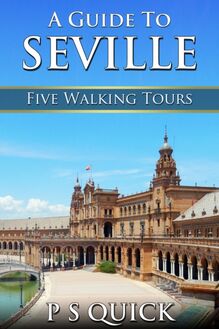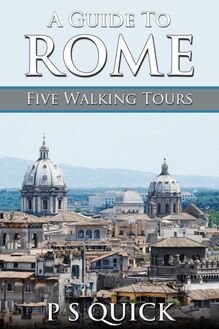Guide to Verona , livre ebook
37
pages
English
Ebooks
2016
Vous pourrez modifier la taille du texte de cet ouvrage
Obtenez un accès à la bibliothèque pour le consulter en ligne En savoir plus
Découvre YouScribe en t'inscrivant gratuitement
Découvre YouScribe en t'inscrivant gratuitement
37
pages
English
Ebooks
2016
Vous pourrez modifier la taille du texte de cet ouvrage
Obtenez un accès à la bibliothèque pour le consulter en ligne En savoir plus
Publié par
Date de parution
22 juin 2016
Nombre de lectures
0
EAN13
9781785385414
Langue
English
Poids de l'ouvrage
2 Mo
Publié par
Date de parution
22 juin 2016
Nombre de lectures
0
EAN13
9781785385414
Langue
English
Poids de l'ouvrage
2 Mo
Title Page
A Guide to Verona
Five Walking Tours
P S Quick
Publisher Information
Published in 2016 by
Acorn Books
www.acornbooks.co.uk
an imprint of
Andrews UK Limited
www.andrewsuk.com
Copyright © 2016 P S Quick
The right of P S Quick to be identified as the Author of this Work has been asserted in accordance with the Copyright, Designs and Patents Act 1998
All rights reserved. No part of this publication may be reproduced, stored in a retrieval system, or transmitted, in any form or by any means without the prior written permission of the publisher, nor be otherwise circulated in any form of binding or cover other than that in which it is published and without a similar condition being imposed on the subsequent purchaser. Any person who does so may be liable to criminal prosecution and civil claims for damages.
All information provided in this guide is correct at the time of publication. If anything is subsequently found to be incorrect, please advise the publishers who will update the text in future editions.
Photo credits:
Juliet’s Balcony courtesy of Elliott Brown
Plan of Piazza delle Erbe courtesy of Pentti
Introduction
The city of Verona is second only to Rome in the antiquities that can be seen. This book aims to give the tourist an opportunity to visit and enjoy not only the few major attractions that a guided tour usually includes but many of the other interesting sights that many people do not see.
It will show you not only the famous amphitheatre, cathedral and sights linked to Romeo and Juliet but also the monumental gateways, the beautiful bridges, castles, fortresses, palaces, gardens, graves, remains of Roman villas and other things that show the magnificence of Verona’s past.
By providing five different walking routes and detailed information about each attraction passed it puts a visitor to Verona in charge of the time spent at any particular place rather than having to rush and keep up with a guide.
With detailed instructions of how to get from one place to another it gives a flavour of the many things that Verona has to offer without having to join costly guided tours.
Preparation Unless you want a guaranteed seat for an opera there is no need to book tickets for tourist sites online as is the case on visits to Rome and some other cities. If you want to pre-book an opera ticket see the links given in the information about the Arena. It is also possible to book an opera seat when you are in Verona although you will not get the same choice as booking early on the internet. If you are prepared to sit on the stone steps rather than in the stalls you can enjoy the show and atmosphere at a much reduced cost. Make sure you either take or hire a cushion to sit on. Visit a tourist office or kiosk as soon as you can on arrival to pick up details of attractions and opening times together with a free map which is essential in order to get your bearings and understand where places are located. Tourist offices can be found just off the Piazza Brà on the Via degli Alpini and also near the railway station. Visit http://www.tourism.verona.it/en for the online tourist site. Hotels usually have free maps and other information for their clients. Do your research and read through this guide in order to decide which museums or other places you want to go into. Most museums and attractions in Verona are open all week but closed on Monday mornings then open at 1:30. Times do vary during the year so check online or with information from the tourist office before you visit. If you are visiting Verona on the first Sunday in a month between October and May then entry to many of the attractions is free. While it is wonderful to sit and enjoy a drink or a meal in the busy piazzas this is often costly and if you are on a budget you will find some good quality competitive restaurants off the main streets. Ask the hotel where the locals eat for the best deals. There are so many things to see when in Verona that this can prove expensive. One option is to buy a Verona Card from the tourist office, tobacco shops, monuments, museums or churches you visit. The card is available for either 24 or 48 hours and also covers the cost of getting from one place to another by public transport. It has a standard price with no discount for students or senior citizens. The Verona Card offers free access to most of the important attractions and a discount off some others. It can save a third off total visiting costs. Take care though as the countdown starts as soon as the card is shown on a bus or at an attraction. Verona has a number of important churches worth visiting and many hold wonderful works of art. There is also a church discount card which covers admission to the Cathedral, San Zeno, Sant’Anastasia and San Fermo. Remember to wear appropriate clothes when visiting. If you don’t want to buy a Verona Card local transport by bus is cheap and fairly frequent. Some of the sights described in this guide are in hilly areas so if you have mobility problems and still wish to visit them then use the local buses. Verona has a sightseeing tourist bus that offers two routes with multiple stops where you can hop on and off over a period of 24 hours. It cannot access many of the small streets but it is one way to get around if you struggle on foot. It is also possible to see Verona by bicycle. With the area surrounded by the old walls linked together by cycle tracks it is both safe and easy to get around. Bikes can be rented and although those at the railway station are free to use they are limited in number and should be booked in advance. If you do choose to follow the routes in this guide then you will be walking long distances so choose sensible shoes. Even if you do not want to go inside the attractions you can view and enjoy the magnificent architecture from outside. While most of Verona is flat some of the sights mentioned are in hilly areas. If you are mobile and fit enough then walking is by far the best way to visit this wonderful city and enjoy all the sights.
View of River Adige and Verona from Castel San Pietro
The First Tour
Today’s walk begins at Porta Nuova City Gate and ends in the Piazza Brà that has a selection of restaurants and cafes where you can relax and watch the world go by at the end of your tour. If you are not staying near the Porta Nuova City Gate you can either make the pleasant walk from the Piazza Brà along the Corso Porta Nuova Road which takes about 9 minutes or take one of the buses 51, 52, 92 or 93 that leave from Piazza Brà every few minutes. Ensure you ask for the Porta Nuova City Gate and not the Porta Nuova railway station.
Main Sights Porta Nuova Museo degli Affreschi Juliet’s Tomb Museo di Storia Naturale Chiesa San Fermo Maggiore Antique Porta Leoni Via Cappello Juliet’s house Teatro Nuovo Novona Square Romeo’s house Chiesa San Tomaso Giardino Giusti Piazza Brà
Porta Nuova
The Porta Nuova or New Gate was designed by the architect Michele Sanmicheli and built between 1532 and 1540 to replace the Scala Porta di Santa Croce in order to renew the defences in the southern part of the city. It was part of the original outer mediaeval city walls of Verona. The architect was also responsible for renovating the existing fortifications, building new walls with imposing towers and also the Porta Palio and the Porta San Zeno gates.
This monument is the first that many people will see when arriving in Verona by train. The majestic stone gateway with Doric Pillars and rustic style is regarded as a great masterpiece of military architecture as well as a work of art. The original lion of Saint Mark near the top has now been replaced by a sculpture of two griffins which stand each side of the coat of arms.
Recent excavations have exposed the bridge that allowed access to the structure over the original deep moat. During the Austrian occupation major changes were made to the building especially on the façade that faces towards the county. Walk around the structure to compare the differences on each side.
From the Porta Nuova city gate walk east on Circonvallazione Raggio di Sole for about 450 metres. You will see the Giardini Raggio di Sole (the Sunshine Gardens) on your right. When you meet Via del Fante turn left. After about 300 metres continue northwards onto Via del Pontiere for 100 metres then turn right onto Via Luigida Porto. Follow this road for 120 metres then turn right onto Via Shakespeare. After 50 metres you will see the Fresco Museum and the tomb of Juliet on the right.
Museo degli Affreschi e Tomba di Giulietta
The Fresco Museum and Juliet’s tomb are located in the monastery of San Francesco. The monastery itself dates back to the thirteenth century when it was the only Franciscan monastery outside the city walls of Verona which is why it was considered to be the most likely place where the lovers were buried.
After Shakespeare wrote his famous love story a real sarcophagus, made from red marble, was placed inside the monastery. It is said that the lid and remains inside were moved by the government to a secret location.
The sarcophagus was moved into the vaults of the monastery in 1937 when a Hollywood film was made and this is where it can be seen today. Many people, including celebrities such as Napoleon’s wife, have continued to visit the monastery to view it.
Today the monastery has been transformed into a museum. It holds a superb collection of fresc



